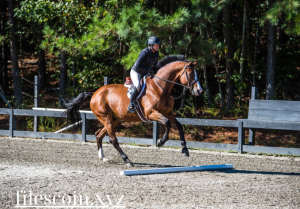Training a racehorse to achieve its full potential requires a deep understanding of the horse’s individual needs and abilities. Whether you’re preparing for prestigious races or focused on long-term athletic development, a custom racehorse training plan is key to maximizing performance while ensuring health and longevity. By tailoring the approach to the horse’s strengths, fitness level, and personality, these plans offer a comprehensive strategy that combines elite conditioning, nutrition, and recovery.
1. Comprehensive Evaluation: Laying the Foundation for Tailored Success
Before diving into a structured racehorse training plan, it’s crucial to start with a thorough assessment. This evaluation sets the groundwork for a customized regimen, helping identify areas that need improvement while maximizing strengths.
- Physical and fitness assessment: From cardiovascular endurance to muscle tone, understanding your horse’s physical state is the first step in developing an effective training plan. Evaluating the horse’s age, conformation, and previous performance history allows for a tailored approach.
- Temperament analysis: Each horse has its own temperament and mental approach to training. Some horses thrive under pressure, while others require a more gradual build-up. Recognizing these traits is essential for a balanced training plan.
- Veterinary check-up: A thorough veterinary evaluation is crucial to rule out any underlying issues that could interfere with training. Addressing past injuries or potential concerns ensures the horse’s health is fully supported.
Ideal for: Establishing a holistic, data-driven foundation for a highly personalized training plan that ensures both safety and optimal performance.
2. Cardiovascular Conditioning: Elevating Endurance to Win
For racehorses, endurance is just as important as speed. A well-designed cardiovascular conditioning program helps the horse maintain high energy levels throughout a race, allowing for a strong finish without succumbing to fatigue.
- Interval training for stamina: Alternating between high-intensity gallops and slower recovery jogs helps improve the horse’s aerobic capacity, building the endurance needed for both short sprints and long races.
- Steady long-distance gallops: Incorporating longer gallops at a moderate pace into the routine allows horses to gradually increase their stamina without overstraining their bodies, ensuring they remain strong and responsive over longer distances.
- Cross-training with hill work: Galloping or trotting up inclines develops both the cardiovascular and muscular systems, giving horses the power and endurance to handle challenging courses.
Ideal for: Horses competing in longer races or those who need to improve their stamina to maintain peak performance over time.
3. Speed Workouts: Sharpening Explosive Power for Race Day
Speed is the ultimate determinant of success on the racetrack. A customized speed training plan will focus on building the explosive acceleration and sprinting power needed for those critical race moments when every second counts.
- Sprint intervals: Short but intense sprints over measured distances develop a horse’s fast-twitch muscles and explosive power, key components for race-winning speed.
- Furlong workouts: By practicing specific distances, horses become familiar with pacing and how to accelerate at the right moments. Furlong drills allow trainers to gauge how the horse is handling various speeds over specific lengths.
- Incorporating rest for recovery: High-speed drills are demanding on the body, and adequate recovery time is necessary to prevent injury and muscle fatigue. Balancing intense workouts with proper recovery ensures longevity and peak performance.
Ideal for: Fine-tuning the sprinting ability of horses competing in short- to mid-distance races.
4. Strength Conditioning: Building Power for Sustained Speed
Strength training plays a pivotal role in racehorse development, especially for maximizing the power behind each stride. A solid custom racehorse training plan will incorporate exercises that build muscle, prevent injury, and enhance overall performance.
- Hill training for strength: Uphill gallops not only improve cardiovascular endurance but also strengthen the hindquarters and core muscles, which are essential for delivering strong strides during races.
- Resistance and paddock work: Simple resistance exercises in the paddock using ground poles or resistance bands help tone the horse’s muscles without putting undue strain on the joints. These workouts enhance flexibility, balance, and overall power.
- Flexibility routines: Incorporating stretching and mobility exercises into the training plan helps prevent stiffness and improves range of motion, allowing for smoother, more powerful movements on the track.
Ideal for: Horses that need additional muscle development and power to maintain speed and perform explosively at critical moments.
5. Tailored Nutrition: Fueling Success from the Inside Out
No training plan is complete without a corresponding nutrition strategy. Custom racehorse training plans should include a personalized nutrition plan that meets the energy demands of the horse’s training regimen, while also supporting recovery and muscle development.
- Carbohydrate-rich diets for energy: High-quality grains like oats and barley provide the energy needed for intense workouts. These should be balanced with protein and fats to ensure sustained energy throughout training.
- Protein for muscle recovery: Post-workout, the body requires protein to repair and build muscle. Including protein-rich sources such as soy, peas, or alfalfa in the diet promotes faster recovery and stronger muscle growth.
- Electrolytes and hydration: Intense training leads to significant electrolyte loss through sweat. Supplementing the horse’s water with electrolytes and ensuring consistent hydration is key for maintaining performance and preventing fatigue.
Ideal for: Supporting both high-intensity performance and swift recovery, ensuring the horse is well-fueled for every stage of training.
6. Recovery and Injury Prevention: Balancing Performance with Rest
One of the most important aspects of a custom racehorse training plan is ensuring adequate recovery and injury prevention. A well-rested horse is more likely to perform at its best, while overtraining can lead to injury and burnout.
- Active rest days: Incorporating light exercise such as walking or trotting on rest days helps prevent stiffness and keeps muscles active without overloading the horse’s system.
- Post-training cool-down: After each workout, gradually cooling the horse down through slow trotting or walking reduces muscle stiffness and encourages proper blood flow to aid recovery.
- Therapeutic treatments: Adding massage therapy, cold-water therapy, or chiropractic adjustments to the recovery plan helps alleviate muscle tension and reduce the risk of injury.
Ideal for: Keeping the horse healthy, injury-free, and in peak condition for upcoming races.
Conclusion: Custom Racehorse Training Plans for Maximum Impact
Designing a custom racehorse training plan is about more than just fitness—it’s about understanding the unique needs of each horse and creating a strategy that nurtures its potential. By focusing on personalized cardiovascular conditioning, speed work, strength development, nutrition, and recovery, trainers can ensure that their horses reach peak performance and stay competitive over the long term. With the right plan, every horse can be prepared to shine on race day.



